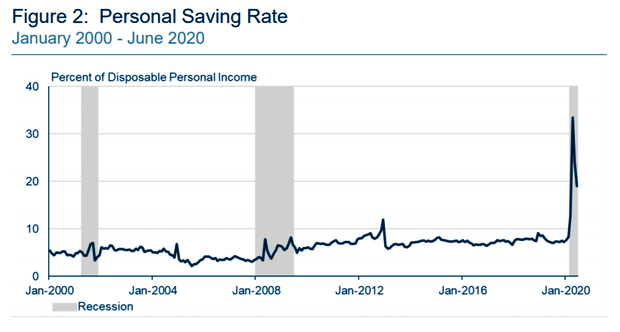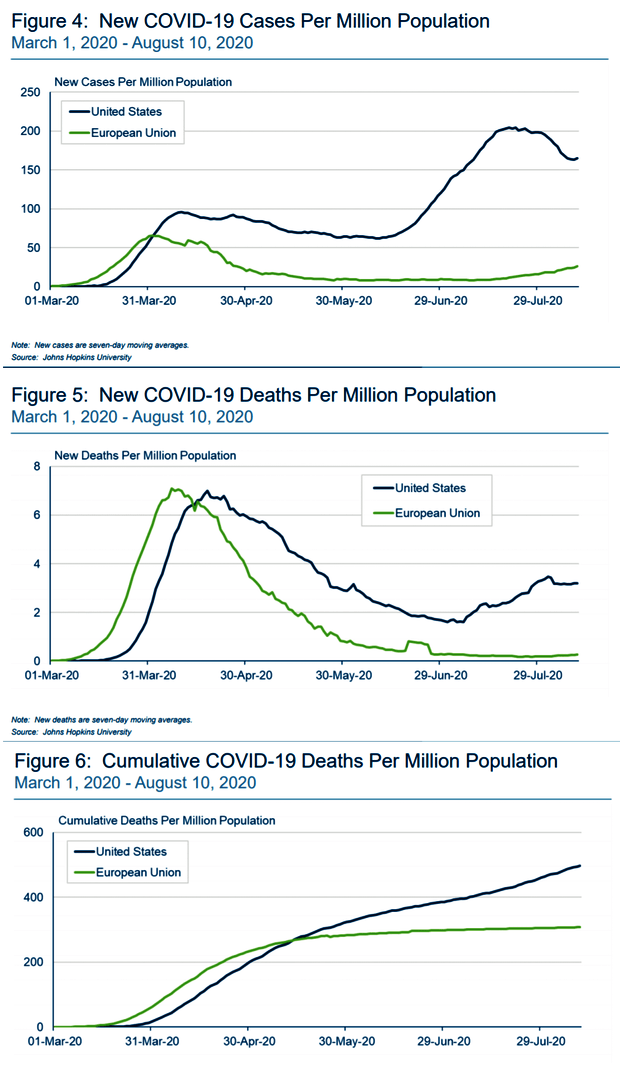Key Takeaways from Boston Fed President Eric Rosengren’s Aug. 12 Remarks
- Takeaway: The path of the economy will depend significantly on the course of the virus. So, limited or inconsistent efforts by states to control the virus are not only placing citizens at health risk, but are also likely to prolong the economic downturn.
Excerpt: “As long as the virus poses significant threats to public health, a full economic recovery will be very difficult as individuals, often voluntarily, avoid activities that place their health at risk. […] Indeed, the trajectory of the economic recovery will be determined more by the path of the virus than by the path of policymaking, although monetary and fiscal policy can mitigate, and have mitigated, some of the most significant adverse impacts.”
- Takeaway: Despite sizeable interventions by monetary and fiscal policymakers, the economic data indicate that the recovery may be losing steam, as activities in many states are once again restricted, officially or voluntarily, to slow the virus’s spread.
Excerpt: “The forecast for this fall is quite uncertain, but my view is that the recent slowdown in economic activity…is likely to continue. Currently, we have an unemployment rate above 10 percent, and because of the continued community spread of the virus, I am concerned that the pandemic will limit the ability of the economy to recover quickly.”
- Takeaway: States that re-opened early saw a temporary economic benefit, but that gain has been short-lived and came at a cost – including rising rates of infections, which have resulted in less spending more recently.
Excerpt: “Lifting restrictions too quickly hurt both the economy and public health down the road. In the Northeast, where restrictions were more substantial and lasted longer, states are now experiencing both better public health outcomes and more spending in sectors of the economy that are sensitive to social distancing.”
- Takeaway: While both Europe and the U.S. had significant increases in infection rates in the spring, Europe enacted more stringent and longer-term shutdowns and limits, and did not reopen until the virus had reached low levels. Their infection rates fell faster and further, and have remained relatively low, and economic activity has been more robust.
Excerpt: “In contrast, in the United States, infection rates remain elevated, as states lifted protective measures too soon and in a manner not calibrated for the true risks posed by the virus.”
- Takeaway: Credit interruptions prolong recessions and harm individuals and businesses, so it is important that the Fed stands ready, with the Main Street Lending Program, to facilitate credit flows that can bridge businesses and nonprofits of many sizes, at reasonable rates.
Excerpt: “The program is attractively structured for many facing cash-flow interruptions due to the pandemic, facilitating 5-year loans with no payment of interest in the first year and no payment of principal until the third year. It is attractive for lenders because they can meet the credit needs in their markets while retaining only 5 percent of the loan on their books, with the Federal Reserve taking a 95 percent participation interest in the loan. […] The Fed is aiming to help [entities] that … given the uncertain outlook, might otherwise have difficulty in obtaining credit from a lender that would have to hold 100 percent of the loan. The Main Street program can provide essential financing to help these entities avoid shutting their doors and permanently laying off their employees.”
- Takeaway: Some suggest that the Main Street program’s modest initial activity is evidence of failure, but Rosengren disagrees completely. The Program is one important way the Fed is doing all it can to support the businesses, nonprofits, and individuals that make up our nation’s economy.
Excerpt: “The numbers seem consistent with a gradual pace of initial activity that is more recently expanding as participants become familiar with the program parameters. […] Loans are contracts between borrowers and banks, and the negotiations for loans can take some time and effort. […] As borrowers and banks have become more familiar with the program, we have seen a steady increase in loans submitted to our portal. There are currently more than $856 million in loans active, with more than $250 million in loans committed or settled. Much of the increase has occurred recently, and I expect we will continue to see more.”
Short Synopsis
Points 1, 2, 5, and 6 address the slowdown.
Points 3 and 4 are in praise of lockdowns.
Point 6 is a self-serving"Don't blame the Fed" call.
What? No Free Money?
The 6-point synopsis was a Boston Fed summation I posted as is. What about more free money?
From the full speech: "Clearly, continued stimulative monetary and fiscal policy are critical."
Here is another cautionary excerpt.
Unfortunately, as long as the virus poses significant threats to public health, a full economic recovery will be very difficult as individuals, often voluntarily, avoid activities that place their health at risk. The increased saving rate, reflecting a falloff in consumption despite substantial fiscal transfers to individuals, illustrates the challenges the recovery faces.
The word "fiscal" came up 13 times. And as expected, Rosengren wants more of it.
Related Charts
Here is a link to the related Boston Fed Charts.
Personal Savings Rate
Cases and Deaths Per Million US vs. EU
There are 14 charts and figures in all.
Pleading for a Lockdown
Third Call for a Lockdown
On August 9 I noted Yet Another Fed President Supports More Free Money and a Covid Lockdown
On August 3 I noted Second Fed President Calls For More Free Money.
Current Running Score
- Three Promote Hard Lockdowns: Fed Presidents, Neel Kashkari (Minneapolis) and Charles Evans (Chicago) support hard lockdowns. Add Eric Rosengren (Boston) to the list.
- Four Promote More Free Money: Fed Presidents, Neel Kashkari (Minneapolis), Charles Evans (Chicago), and Thomas Barkin (Richmond) support more free money. Add Eric Rosengren (Boston) to the list.
Rosengren was far more subtle in his statements than the others but it is clear what he is angling for.
Heaven Help Us if Unemployment Follows the Path of the Great Recession
In regards to jobs, please see Heaven Help Us if Unemployment Follows the Path of the Great Recession.
Also note Millennials Screwed Again, This Time on Unemployment.
This material is based upon information that Sitka Pacific Capital Management considers reliable and endeavors to keep current, Sitka Pacific Capital Management does not assure that this material is accurate, current or complete, and it should not be relied upon as such.
Recommended Content
Editors’ Picks
EUR/USD hovers around 1.0700 ahead of German IFO survey

EUR/USD is consolidating recovery gains at around 1.0700 in the European morning on Wednesday. The pair stays afloat amid strong Eurozone business activity data against cooling US manufacturing and services sectors. Germany's IFO survey is next in focus.
GBP/USD steadies near 1.2450, awaits mid-tier US data

GBP/USD is keeping its range at around 1.2450 in European trading on Wednesday. A broadly muted US Dollar combined with a risk-on market mood lend support to the pair, as traders await the mid-tier US Durable Goods data for further trading directives.
Gold: Defending $2,318 support is critical for XAU/USD

Gold price is nursing losses while holding above $2,300 early Wednesday, stalling its two-day decline, as traders look forward to the mid-tier US economic data for fresh cues on the US Federal Reserve interest rates outlook.
Crypto community reacts as BRICS considers launching stablecoin for international trade settlement

BRICS is intensifying efforts to reduce its reliance on the US dollar after plans for its stablecoin effort surfaced online on Tuesday.
Three fundamentals for the week: US GDP, BoJ and the Fed's favorite inflation gauge stand out Premium

While it is hard to predict when geopolitical news erupts, the level of tension is lower – allowing for key data to have its say. This week's US figures are set to shape the Federal Reserve's decision next week – and the Bank of Japan may struggle to halt the Yen's deterioration.



